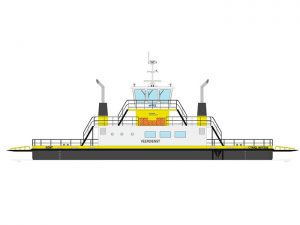
Damen books order for Voith Schneder propelled inland ferry
EBRUARY 13, 2017 — Damen Shipyards Group reports that its last newbuilding order of 2016 was signed December 31 with VLOOT dab of Belgium and is for a 25 m ferry to

EBRUARY 13, 2017 — Damen Shipyards Group reports that its last newbuilding order of 2016 was signed December 31 with VLOOT dab of Belgium and is for a 25 m ferry to
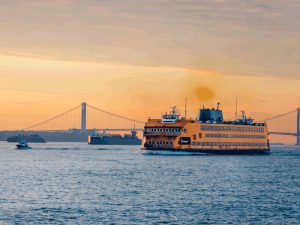
Considered the “forgotten borough” by some New Yorkers, Staten Island is on the verge of making its presence known in the city that never sleeps. The borough is a 25-minute ferry ride from the lowest tip in Manhattan, the Staten Island Ferry terminal at Whitehall.
Staten Island’s plan for renewal includes a $1.2 billion investment that will see the construction of the New York Wheel at St. George—an impressive 630 ft tall observation wheel that will rival England’s infamous London Eye, and feature 36 pods with accommodations for 40 in each, on a 38 minute ride/revolution, giving passengers a spectacular view of New York Harbor. Alongside the New York Wheel, New York City’s first outlet mall, Empire Outlets, is currently being constructed at St. George. The mall will feature 350,000 square feet of retail, 100 different shops and a 190-room hotel. Both the New York Wheel and Empire Outlets are expected to be operational by 2018.
How will tourist, potential shoppers, and New Yorkers alike make their way to these new attractions? They’ll be taking the Staten Island Ferry of course. The fleet, currently comprised of nine ferries, carries 22 million passengers a year—second only to Washington State Ferries’ fleet which carries over 23 million passengers annually.
And come 2019, the Staten Island Ferry fleet will welcome a new class to its fleet—the Ollis Class ferries.
Designed by Seattle-based Elliott Bay Design Group, the Ollis Class will mix the new with a bit of the old, providing passengers with a faster, more efficient ride to help meet increased ridership demand.
Its design will give the 320 ft x 70 ft ferries a striking resemblance to the beloved John F. Kennedy—which was commissioned in 1965 and is one of the oldest ferries in the Staten Island Ferry fleet. The Kennedy is one of three-that will be retired once the new Ollis Class series is delivered—the S.I. Newhouse and Andrew J. Barberi, both commissioned in 1981 are the other two.
The new Ollis Class will be double-ended and have capacity for 4,500 passengers; and like the Kennedy, will feature plenty of open air space, enabling passengers to enjoy the harbor view. The ferries will be built to ABS class requirements and will be powered by Tier 4 EMD engines and Voith Schneider Propulsion Drives.
The first of the three ferries will be named in honor of U.S. Army Staff Sgt. Michael Ollis, a native Staten Islander who died while saving another soldier in Afghanistan. He was only 24 years old.
The Staff Sgt. Michael Ollis ferry is expected to begin operations in 2019, with vessels two and three following later in 2019 and 2020.
Building the Ollis Class
As we were going to press, yards were putting in their final bids for the ferry project.
Among the yards that have expressed interest in the Ollis Class—at least according to the 2015 Industry Day attendance—are Conrad Shipyard, Eastern Shipbuilding Group, Fincantieri Bay Shipbuilding, and Vigor. All are builders of a variety of vessel types including ferries.
Conrad Shipyard—which has won a number of newbuild contracts this year — has had its share of ferry projects in the past, and is looking to keep the momentum going.
As Dan Conrad, Conrad Shipyard’s Senior Vice President and Director, explains, “Conrad Shipyard has a great track record on deliveries to the Puerto Rico Maritime Authority, the Texas Department of Transportation, the State of North Carolina and the Alaska Marine Highway, among others.” And he assures that his team is committed to pursuing the ferry market for years to come.
Most recently, Conrad’s Conrad Aluminum, Amelia, LA, yard delivered the M/V Woodshole to the Steamship Authority. The 235 ft x 64 ft ferry was designed by Elliott Bay Design Group and has capacity for 384 passengers, 55 automobiles or 10 eighteen-wheel tractor-trailers.
Eastern Shipbuilding Group is said to have the inside track on building the Ollis Class ferries, according to our sources. It would be quite a month for the Panama City, FL-based shipyard, which recently secured the lucrative contract to build the OPC for the U.S. Coast Guard.
Meanwhile, Fincantieri’s recent expansion is helping it position its Bay Shipbuilding yard for larger projects that can be produced and worked on, year-round. The three-acre expansion will pave the way for additional covered fabrication and erection facilities, an indoor paint and coating building, and outfitting shop that will enable FBS to increase its pursuit of ferry projects.
“This expansion allows us to increase our capacity and positions us to pursue a number of new construction markets, including large passenger ferries,” said FBS Vice President and General Manager Todd Thayse. “Our experience in building ferries and other complex passenger vessels dates back to our origins almost a hundred years ago, and includes the New York Staten Island Ferry now operating (the Guy V. Molinari). We have the people, the experience, the facilities, and the global resources of Fincantieri to ensure that we can tackle the most challenging construction projects.”
As for the shipbuilding powerhouse in the Northwest, Vigor, it’s currently working on six ferry projects at the moment, including the final two vessels in Washington State Ferries’ new 144-car Olympic Class.
 “Vigor has deep expertise in the ferry market with successful, on-time and on-budget deliveries of car ferries, passenger only vessels and catamarans. Six ferries are currently under construction at our Washington and Alaska yards and we expect ferry construction to continue to be a focus in our business development efforts, leveraging our considerable experience,” said Corey Yraguen, Vigor Executive VP of Fabrication.
“Vigor has deep expertise in the ferry market with successful, on-time and on-budget deliveries of car ferries, passenger only vessels and catamarans. Six ferries are currently under construction at our Washington and Alaska yards and we expect ferry construction to continue to be a focus in our business development efforts, leveraging our considerable experience,” said Corey Yraguen, Vigor Executive VP of Fabrication.
Just last month the Chimacum, the third in the series was christened at Vigor’s Harbor Island yard. The fourth vessel in the series, the Suquamish, is currently under construction and scheduled for completion in 2018, with operations set to begin in 2019.
The 144-car ferries are the result of a combined effort from a consortium of Northwest based companies, including Nichols Brothers Boat Builders, Freeland, WA, which has been in charge of building the superstructures for the144-car ferries.
In other Vigor ferry news, Vigor’s Ballard Facility (formerly Kvichak Marine) is building two 400 passenger ferries for the Water Emergency Transportation Authority of San Francisco (WETA). The Incat Crowther designed ferries will travel 27 knots and are scheduled for delivery Summer 2017.
And Vigor’s Ketchikan yard in Alaska has taken up the task of constructing the highly anticipated 280 ft Day Boat ferries for the Alaska Marine Highway System. The ferries, designed by Elliott Bay Design Group, are scheduled to be completed Fall 2018.
Vigor’s Executive VP of Business Development, Keith Whittemore, will be discussing Vigor’s ferry projects and more at the Marine Log Ferries Conference & Expo November 3 & 4, 2016, Seattle, WA. Attendees of the event will also have the chance to tour Vigor’s Harbor Island yard after the conference’s conclusion. Learn more at www.marinelog.com/events
Route Extension?
Staten Island Borough President, James Oddo sparked additional interest in the Staten Island Ferry system when he requested the New York City Department of Transportation explore the feasibility of extending the Staten Island Ferry’s route north of the Whitehall Terminal, possibly extending the service into midtown.
While the idea sounds great in theory, and will certainly foster a sense of “transit equality” for Staten Islanders who have a grueling commute (just ask our Editor-in-Chief, John Snyder), the route extension could prove problematic as there is currently no operating terminal in place in midtown, with the right infrastructure to handle such large vessels.
 New York’s Ferry Boom
New York’s Ferry Boom
Of course, the Staten Island Ferry isn’t the only New York City ferry operation making waves. Operated by Hornblower NY, Citywide Ferry Service’s new fleet of ferries are currently under construction at Louisiana-based Metal Shark Boats and Alabama’s Horizon Shipbuilding. The contract catapults both yards into new markets—propelling Metal Shark into the commercial market in a very big way, and introducing Horizon to the ferry market.
A large portion of the Incat Crowther-designed ferries are expected to be delivered in time for Citywide Ferry Service’s launch Summer 2017. The service, according to the New York City Economic Development Corporation is projected to make 4.6 million trips annually.
The 85 ft ferries will have capacity for 150 passengers, as well as space for bikes, strollers and wheelchairs. The Citywide Ferry Service is expected to add five new routes on the East River.
Meanwhile, another well-known ferry operator in New York harbor is upping its stake in the market. Seastreak says its “raising the bar in fast passenger ferry service” with the addition of a new, high-speed, 600-passenger, catamaran in 2017. The ferry will be the highest passenger capacity USCG K-class high speed ferry in the U.S.
The addition of the new ferry will help Seastreak meet growing passenger demand on the New Jersey to New York route.
 Designed by Incat Crowther, the ferry, the first in Seastreak’s new Commodore class, will be 147 ft 8 in x 39 ft 5 in. The vessel was designed to provide Seastreak with an operational advantage. The ferry’s boarding arrangement will include large forward and aft side gates as well as an adjustable bow ramp. This will help facilitate turnaround times at terminals.
Designed by Incat Crowther, the ferry, the first in Seastreak’s new Commodore class, will be 147 ft 8 in x 39 ft 5 in. The vessel was designed to provide Seastreak with an operational advantage. The ferry’s boarding arrangement will include large forward and aft side gates as well as an adjustable bow ramp. This will help facilitate turnaround times at terminals.
The first vessel in the series will be built at Gulf Craft Shipyard, Franklin, LA. Construction is to be completed by 3rd quarter 2017. Meanwhile, Seastreak expects a keel to be laid for a second Commodore class vessel before the end of 2016.
The Commodore Class ferry will be powered by four MTU 12V4000 M64 EPA Tier III main engines, each delivering 1,875 hp at 1,800 rev/min and driving Rolls-Royce KaMeWa 63S4 waterjets. The vessel will also feature LED lighting and an advance energy efficient HVAC system.
The ferry’s main deck will hold 234- passengers; mid deck will seat 271 passengers inside and 52 passengers outside; and the third deck features 160 exterior seats as well as the vessel’s wheelhouse.
Seastreak is also initiating the upgrades and repowering of several members of its current operating fleet. First one up will be the Seastreak New York, which is expected to enter into drydock this coming winter. At press time, the bids were out to multiple yards. The repowering project is expected to be completed by the end of the 1st quarter 2017.
Florida gets in the game
New York isn’t the only city getting its ferry action on. This month, service officially begins on the Cross-Bay Ferry system—connecting St. Petersburg and Tampa, Fl. The service is part of a pilot project intended to introduce residents and visitors to water transit services in the area.
The route will be operated by the 98 ft twin-hull aluminum catamaran, Provincetown IV. The ferry was originally built for Bay State Cruise Company, Boston, MA, by Gladding-Hearn Shipbuilding, the Duclos Corporation, Somerset, MA. Designed by Incat Crowther, the 149-passenger ferry can operate at a top speed of up to 30 knots on the 50 minute route.
“We only have one vessel, and one crew, so we cannot do everything, but we do mean to showcase this technology to a lot of people and test ferry service in a variety of ways and markets,” said Ed Turanchik, policy advisor for the project.
Organizers of the project are testing the service on a variety of different market segments including tourist and local commuters, and the entertainment and sports markets. Learn more about the project at CrossBayFerry.com.
VDOT accepts ferry bids
Last month, the Virginia Department of Transportation was accepting bids for a new 70-vehicle ferry based on a design by Alion Science. The boat would be a replacement for the VDOT’s oldest ferry, the Virginia, built in 1936. Construction on the steel-hull ferry is to start this fall with completion in 2018.
Gladding Hearn delivers high-speed ferry
Gladding-Hearn Shipbuilding, the Duclos Corporation, recently delivered a new 493 –passenger, high-speed Incat Crowther designed ferry to Hy-Line Cruises, a division of Hyannis Harbor Tours, Inc., Hyannis, MA.
The all-aluminum ferry is 153.5 ft x 35.5 ft and is powered by four Cummins QSK60-M, EPA Tier 3 diesel engines each delivering 2,200 bhp at 1,800 rev/min. Each engine will power a Hamilton HM721 waterjet through a Twin Disc MG61500SC horizontally-offset gearbox.
Incat Crowther says the ferry represents an evolutionary step from its previous designs built by Gladding-Hearn. According to the designer, the capacity increase had to fit within docking constraints, enforcing upper limits on both the length and beam of the vessel. To meet the requirements, it moved the wheelhouse to a third deck, freeing up the front end of the second deck for VIP passengers.
The restructuring shifted boarding arrangements, with the addition of a middeck boarding door and both forward and aft stairways improving passenger flow and turnaround times, says Incat.
The ferry will provide year-round service between Hyannis and Nantucket Island. It will top speeds of over 34 knots when fully loaded at a deadweight of more than 64 tonnes, said Peter Duclos, President of Gladding-Hearn.
The new ferry is also outfitted with a Naiad Dynamic trim-tab, ride-control system to help improve passenger comfort and safety. The system’s motion sensor measures the relative movement of the vessel and transmits a signal to the hydraulic device to counter the boat’s actions through the waves.
Europe’s Ferry Market
The European ferry market remains in the forefront of technology. The continent that gave the world emission-free, battery operated ferries, will now give forth, the world’s largest hybrid ferry.
Just last month, Norway’s Color Line reported that it would order the largest hybrid ferry ever built. The ferry, which will feature batteries charged via green electricity from dedicated shore side facilities, or recharged on onboard via the ship’s generators, would double the capacity of the vessel it will replace.
Tentatively named the “Color Hybrid, the ferry will be 160 m long and have capacity for 2,000 passengers and up to 500 cars. The ferry is expected to be put into service on the Sandefjord, Norway to Stromstad, Sweden route in 2020.
 And not to be outdone, Damen says its ready to launch its first composites-construction Water Bus. As we were going to press, the prototype was prepping to begin sea trials.
And not to be outdone, Damen says its ready to launch its first composites-construction Water Bus. As we were going to press, the prototype was prepping to begin sea trials.
The Damen Water Bus is the first vessel for public transportation produced at Damen Shipyards, Antalya, Turkey. Its benefits are plentiful—the vessel, which features a slender hull, making it lighter than a traditional aluminum vessel, requires less fuel consumption, less maintenance, will suffer from no corrosion or fatigue problems. It can travel at speeds up to 21 knots and has capacity for 100 passengers.
Damen’s Design & Proposal Engineer, Fast Ferries, Marcel Elenbaas, explains that the Water Bus is built using high quality vacuum infusion technology that creates a “difficult to penetrate closed cell, epoxy sandwich structure.”
Damen says the vessel is ideal for highly congested urban areas, and is a simple and efficient way for using a city’s natural waterways system.
The Water Bus is equipped with two, forward facing, double-screw podded propulsion units—helping to reduce vibrations. Damen says the vessel can be easily adapted to customer specifications, and because of the nature of the composites’ production process, delivery to clients will be quick.
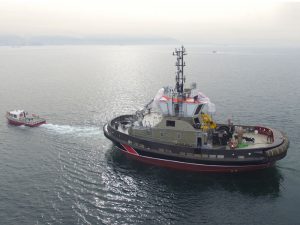
MARCH 8, 2016 — Designed by Robert Allan Ltd in collaboration with Turkish shipbuilder Sanmar Shipyards and Voith Turbo Propulsion, the VectRA 3000 class tug is a high performance VSP tractor tug
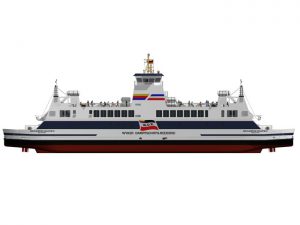
Neptun Werft delivered the operator’s current flagship, Schleswig- Holstein, in 2011.The newly contracted vessel is due for delivery in February 2018. The contract price has not been disclosed.
“Neptun has provided us with an attractive offer and thus succeeded to compete against a number of other reputable German and European yards,” said WDR Managing Director Axel Meynköhn.
The newbuilding will replace the 1992-built conventional ferry Rungholt, which will be offered for sale.
S 578, as the project is currently designated, will be a near sister to the 2011-built Schleswig-Holstein and the series prototype, Uthlande, which was delivered by Sietas Werft in 2010.
Based on extensive research and external scientific consultation, WDR has again opted for a diesel-mechanic propulsion driving four Voith-Schneider propellers.
With identical main dimensions to Schleswig-Holstein (75.88 m long x 16.40 m wide), S 578 will also have the same maximum passenger capacity of 1,200 in day traffic. The car deck has, however, been modified to increase capacity for trucks. It will be the first WDR ferry to accommodate trucks on up to four lanes. With approximately 350 lane meters for private cars and 280 lane meters for cargo, S 578 will have significantly more capacity than the ship it is replacing, the Rungholt.
The inauguration of the new ship will see WDR operate three double-ended ferries on the Föhr-Amrum-Line from spring 2018. The 1995- built conventional ferry Nordfriesland will be retained as a fourth ship to cover seasonal traffic in summer and replacement operations in the off-season.
Neptun Werft Managing Director Manfred Müller-Fahrenholz, says the committed after-sales service provided to the “Schleswig-Holstein” has – along with a competitive offer – helped to win the new contract to Rostock.”With the delivery of S 578,” he says, “WDR will have an extremely young and eco-friendly fleet. In contrast, other European domestic operators are yet facing the replacement of their current short-distance ferries. We aim to contribute to this process and hope to support also other operators in bringing their fleet up to latest technical and environmental standards.
WDR’s newest ferry has, like the Schleswig-Holstein, been designed according to the strict requirements of the German eco-standards RAL-UZ 141 and RAL-UZ 110, which formulate the standards for the German Blauer Engel (Blue Angel) ecolabel in the categories of Environmentally Friendly Ship Design as well as Environmentally Friendly Ship Operation.
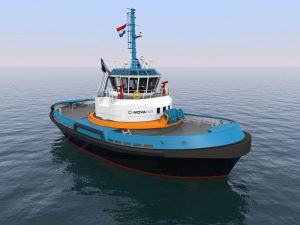
Additionally, Multraship has also agreed a deal with Damen for a new state-of-the-art ASD 3212 tug as part of its planned fleet expansion
Construction of the CRTs will begin immediately. The hulls of the vessels will be built by German shipbuilder Theodor Buschmann GmbH in Hamburg, with final outfitting carried out by Damen Maaskant Shipyards in Stellendam, the Netherlands. Delivery of the Bureau Veritas-classed vessels is scheduled for first-quarter 2017.
The Carrousel towing system consists of a towing point on a straightforward steel ring, freely rotating around the superstructure of the tug. According to Novatug, a towing load simply cannot capsize a Carrousel tug and the tug’s own hull profile can safely be used for generating braking and/or steering forces, based on the lateral resistance of the hull through the water and given the kinetic energy present in the moving tow and/or the current.
In the CRT, this towing system is combined with the advantages of the RAVE Tug (Robert Allan Ltd. – Voith Escort) jointly developed by naval architectural consultancy Robert Allan Ltd. and Voith Turbo Marine. The unique characteristic of the concept is the longitudinal alignment of two Voith drives, delivering very precise and improved force generation characteristics.
The CRTs have an overall length of 32 m, and a bollard pull of minimum 70 tonnes. Propulsion is via two Voith thruster units and two ABC main engines of 2,650 kW operating at 1,000 rpm. Free running speed is over 14 knots at 5,300 kW.
The CRT’s combination of low operational costs, speed of action and enhanced control over the tow can provide major advantages over conventional tugs, for example by widening or even removing tidal and/or weather windows for certain ports.
Novatug will offer the Carrousel Rave tugs on the basis of long-term bareboat charters, basically a financial or operational lease construction, an arrangement proven in other capital-intensive industries such as aviation. Its customer for the first two units is its parent, Multraship.
Leendert Muller, managing director of Multraship, says, “Safety is always our overriding objective, and that it is why we have opted wholeheartedly to produce the Novatug CRT. This new tug design, for the first time, eliminates what has always been the most significant threat to safety in towing – the risk of capsizing under a tow load. The benefits in terms of efficiency and flexibility, meanwhile, are also enormous.”

Carrousel Rave Tug
ASD TUG
The new state-of-the-art ASD 3212 tug acquired by Multraship — the Dutch-flag, LR-registered Multratug 31 — was built at Damen Song Cam, Vietnam. A sister vessel to Multratugs 19, 29 and 30, it will operate mainly in the Western Scheldt area. It has a maximum bollard pull of 83.2 tonnes and a maximum speed of 15 knots.
The 453 gt vessel is powered by two Caterpillar 3516C engines and has two Rolls Royce Azimuth thrusters and a 2,800 mm-diameter controllable pitch propeller.The vessel’s deck layout features a hydraulically driven escort double drum winch forward and single drum aft, and a 25 mt deck crane. There are two one-man cabins, four two-man cabins, a mess room and galley.
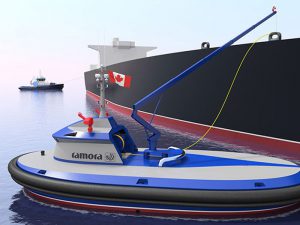
Drone technology is also finding applications in the maritime industry for the same reasons.
“We see opportunities to use robotics to reduce the danger to crews posed by riskier tug operations, and to reduce costs in some cases,” says Mike Fitzpatrick, President & CEO of Vancouver-based naval architectural firm Robert Allan Ltd. “Control and digital communication technologies developed for drones used in other sectors have reached the point where its transfer to our industry is completely feasible, and is perhaps overdue. These technologies have been used in smaller autonomous surface vessels (ASVs), autonomous mine trucks, autonomous underwater vehicles (AUVs) and aerial drones for years.”
Robert Allan Ltd. (RAL) has just unveiled an autonomous tug concept called the RAmora. The first in the company’s TOWBoT (Tele-Operated Workboat or Tug) series, the RAmora 2400 is a versatile towing platform designed primarily for ship assist and berthing operations. With a bollard pull of 55 tonnes, the RAmora 2400 features a hybrid propulsion system and ample battery storage capacity to enable extended operation even in potentially hazardous environments such as LNG terminals or fire-fighting situations.
The RAmora is operated remotely by a captain on a command tug using a console equipped with live video and other positioning information. “It is also possible,” explains Fitzpatrick, “for the RAmora captain to operate RAmora away from the console by a bellypack controller when in close visual range.”
The control system design was developed in partnership with International Submarine Engineering of Port Coquitlam, Canada, and is derived from proven remotely operated vehicle, autonomous underwater vehicle and surface vessel applications.
RAmora is fitted with Voith Schneider Propeller (VSP) drives arranged in a fore/aft configuration and its hull form, designed for high stability and good seakeeping performance in waves, is the product of extensive development work including CFD and towing tank testing. Yet, being a TOWBoT with no need for a conventional wheelhouse, crew accommodations, domestic systems or lifesaving equipment, RAmora is simpler and more compact than any conventional tug of comparable performance.
Other features incorporated into the RAmora include off-ship fire-fighting (fi-fi) capability classed to “Fi-Fi 1”, two 1,200 m³/hr fire monitors supplied by electrically-driven fire-fighting pumps, a crane boom that can be optionally fitted with a smaller 600 m³/hr fire monitor and camera.
RAmora can be used for ship handling operations that can put crew at risk, for operations at terminals where ship handling may be required in emergency situations in hazardous environments, or as a fire fighting asset that can work in close proximity to a toxic fire, or in a restricted space, for extended periods with no risk to crews.
But don’t expect the RAmora to appear in the market overnight. “While the core control and communication technologies are mature,” cautions Fitzpatrick, “there is a lot of work to be done to get to the point where industry, class and regulatory authorities are completely satisfied that safety and reliability meet or exceed what is presently achieved with conventional tugs for the type of ship handling operations that RAmora is intended for. That process could take several years, and we need to be realistic about that. On the other hand, building a prototype RAmora could be done in as little as one to two years since there are no major technological obstacles. We see it as more of an exercise in integrating existing technologies. In many respects, without the normal outfitting required for a crewed tug, RAmora is simpler to build and has considerably fewer systems.”
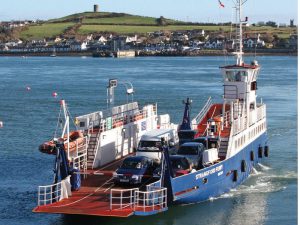
JUNE 23, 2015 — A double ended ferry under construction at the Cammell Laird shipyard in Birkenhead, England, will replace an existing ferry on the route between Strangford and Portaferry in County
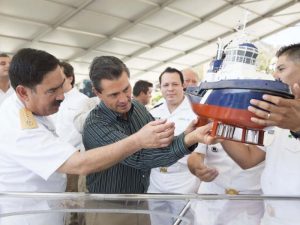
FEBRUARY 11, 2015 — Construction of the first four of nine Voith Water Tractor (VWT) tugs has started at Mexico’s Astimar 20 shipyard with a keel laying ceremony that was attended by
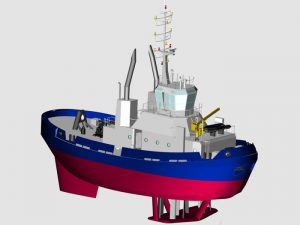
APRIL 15, 2014 — Spanish shipbuilder Zamakona Yards has won an international tender to build a 70 ton bollard pull Voith Schneider tug for the Port of Haifa, Israel. The tug is
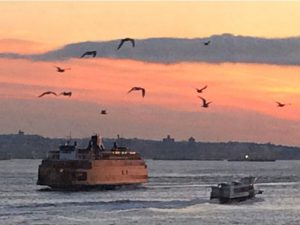
MARCH 24, 2014—Senator Charles E. Schumer (D-NY) is urging the federal government to provide $267 million in funding for a New York City Department of Transportation plan to build three new 4,500-passenger